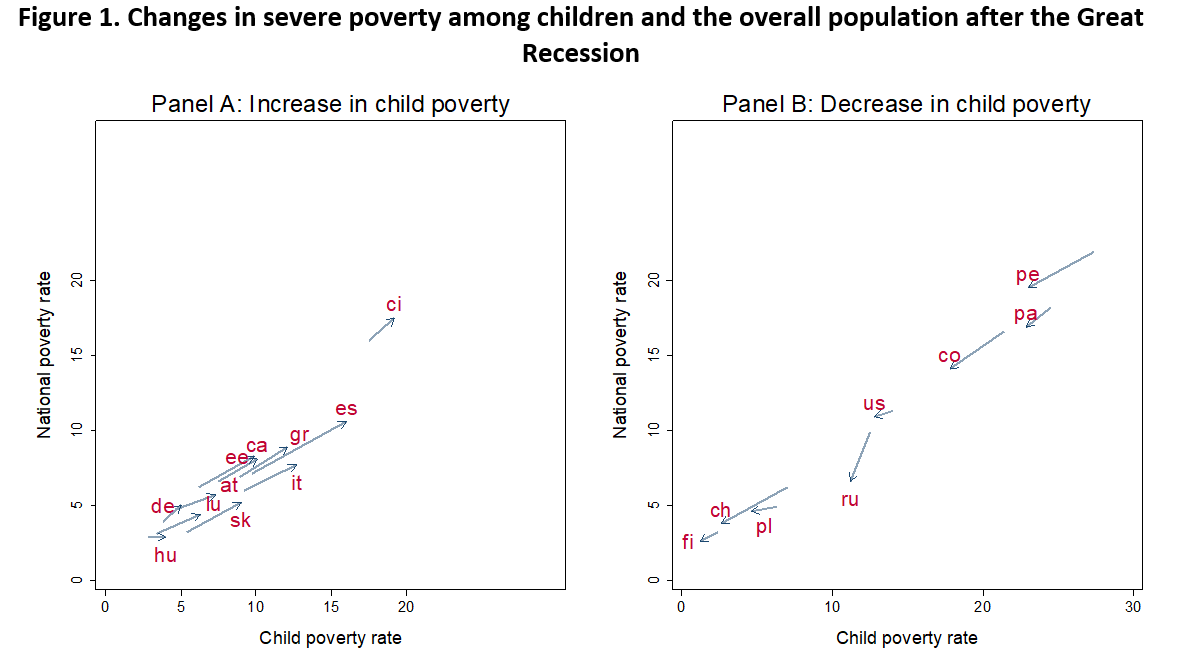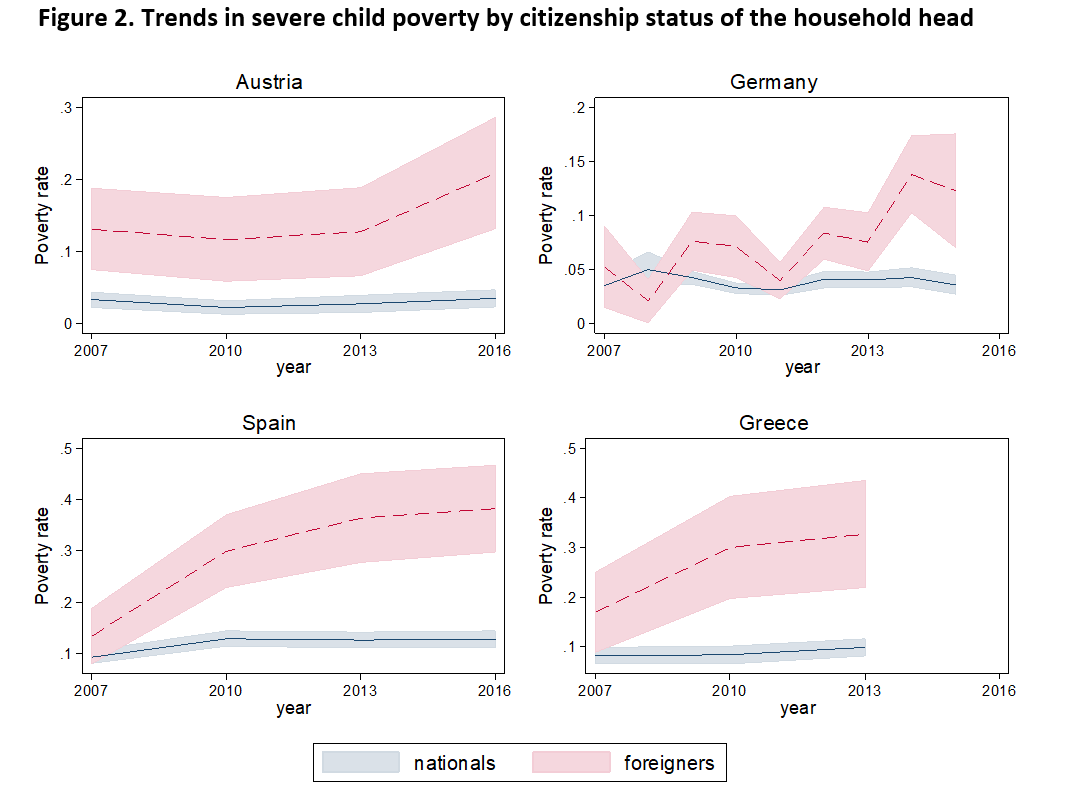Issue, No.11 (September 2019)
Trends in child poverty in LIS countries since the Great Recession
The recent global economic crisis of 2008 has had severe effects on the employment and living conditions of adults and children in many countries. According to Thévenon et al. (2018), child poverty increased by two thirds in the OECD countries during the Great Recession, leaving one in seven children income-poor. Factors such as falling parental and maternal employment rates and wages, lack of support provided by the welfare state, and changes in family composition were among the factors identified behind this change. While poverty at any age is of concern, child deprivation is a particularly sensitive issue not only from an ethical point of view but also due to severe societal consequences. Among other things, child poverty has been linked to a myriad of lifelong problems such as poor health, low educational attainment and poor employment prospects later in life. It is therefore crucial to monitor child poverty and identify the characteristics of households where poor children reside in order to close the poverty gap.
In this note, we look at the trends in severe child poverty in LIS countries since the Great Recession. A child is considered poor when he or she lives in a household with equivalised household disposable income (henceforth – income) below 40% of the country median income. The LIS equivalence scale (household income divided by the square root of household members) is used to account for economies of scalei. While the poverty indicator calculated by EUROSTAT using the threshold of 60% of median income is considered the at-risk-of-poverty rate, incomes falling below the 40% median income threshold can be interpreted as severe povertyii. We use a relative or floating poverty line because it reflects children’s wellbeing with respect to the rest of the country. Alternatively, an absolute or fixed poverty line could be used to measure changes in real disposable income over time. In countries with growing income, poverty rates estimated using the relative poverty line will be higher compared to the poverty rates estimated using the absolute poverty line. The reverse will be true in countries with declining income. Child poverty and the effectiveness of public policies targeted at poverty reduction in LIS countries, such as child allowances and other family transfers, have been investigated recently, amongst others by Cuesta et al. (2018), Evans et al. (2018) and Gornick & Nell (2018)iii

Note: The figure shows changes in severe child poverty between the years 2007/2008 and the most recent available year in the LIS dataset: year 2016 for Austria, Estonia, Poland, Russia and the US; year 2015 for Ivory Coast, Germany and Hungary, year 2014 for Italy, and year 2013 for Canada, Switzerland, Colombia, Estonia, Finland, Greece, Luxembourg, Panama, Peru and Slovakia. Poverty is defined as income below 40% of median equivalised household disposable income in each country in a given year.
Source: Luxembourg Income Study (LIS) Database.
Figure 1 shows trends in national and child poverty rates in LIS countries since the Great Recession.iv We find that more than half of LIS countries saw an increase in severe child poverty rates, and child poverty rates rose faster than national poverty rates (Panel A). Child poverty rose in many EU countries, in particular, the Southern EU countries such as Greece, Italy and Spain, which were some of the most severely affected countries by the Great Recession. Similar but less pronounced changes can also be observed in some Eastern EU countries such as Estonia and Slovakia, as well as Western EU countries such as Germany and Austria. On the other hand, in most LIS countries with favourable poverty trends, child poverty fell faster than national poverty (Panel B). This was the case in some of the Southern American countries with above-average poverty rates, such as Peru, Panama and Colombia, as well as low-poverty EU countries such as Denmark, Finland and Poland. In Russia, on the other hand, national poverty rates fell faster than child poverty.

Note: The figure shows changes in child poverty (defined as income below 40% of median equivalised disposable income in each country in a given year) since the Great Recession. We consider children as nationals if they live in households where the head of the household is a citizen of the country (including having a double nationality) foreigners otherwise. 95% confidence intervals are shown by the shaded area.
Source: Luxembourg Income Study (LIS) Database.
A closer look at country data shows that increases in child poverty did not affect all population groups equally. For example, in some of the LIS countries for which data pertaining to immigration status is available, we find a disproportional increase in child poverty among children living in households with a household head who is not a citizen of the country (Figure 2). In fact, we find that differences in child poverty rates at any given moment tend to be more pronounced when citizenship status is considered rather than a broader definition of being an immigrantv. This is not surprising since naturalisation offers additional benefits beyond the right to vote, such as easier access to employment (including public sector employment) and better-paid and higher-skilled occupations, as well as a stronger position in the housing market (OECD/EU, 2018)vi.
The descriptive results presented in this note suggest that changes in poverty rates among children, both positive and negative, have been larger than changes in national poverty in most LIS countries during the Great Recession of 2008. Country-level trends in child poverty by citizenship status in some LIS countries suggests that the increase in child poverty has not been equally distributed within different socio-economic groups. Trends in child poverty by citizenship status and other characteristics such as family type, education and employment of household members, could be analysed in more detail using LIS data.
i For a discussion on how the choice of equivalence scales might affect estimates of child poverty, see note by Heba Omar in the previous LIS Newsletter issue.
ii For country-year estimates and methodological notes, see LIS Key Figures.
iii For more papers on child poverty using LIS data, see LIS working paper series.
iv LIS countries with changes in poverty rates of 1 p.p. or less during the analysed period are not included.
v See METIS for more details on immigration variables in the LIS dataset.
vi See, for example, how the immigrant-native gap in employment and wages in selected LIS countries (using a broader definition of immigration status than citizenship) has been described by Andrej Cupak and colleagues in an article in the previous LIS Newsletter issue.
References
| Cuesta, L., Hakovirta, M., & Jokela, M. (2018). The antipoverty effectiveness of child support: Empirical evidence for Latin American countries. Social Policy & Administration, 52(6), 1233-1251. |
| Evans, M., Hidalgo, A., & Wang, M. (2018). Universal Child Allowances in 14 Middle Income Countries: Options for Policy and Poverty Reduction (No. 738). LIS Cross-National Data Center in Luxembourg. |
| Gornick, J. C., & Nell, E. (2018). 23. Children, poverty and public policy: a cross-national perspective. Handbook of Family Policy, 308 |
| OECD/EU (2018), Settling In 2018: Indicators of Immigrant Integration, OECD Publishing, Paris/EU, Brussels,https://doi.org/10.1787/9789264307216-en. |
| Thévenon, O., et al. (2018), “Child poverty in the OECD: Trends, determinants and policies to tackle it”,OECD Social, Employment and Migration Working Papers, No. 218, OECD Publishing, Paris, https://doi.org/10.1787/c69de229-en. |
